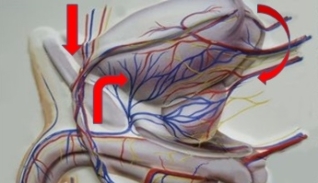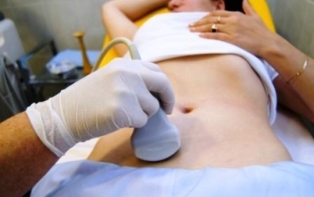Varicose veins of the pelvis or the syndrome of chronic pelvic pain is, to date, of the exotic disease with a clear diagnosis of the borders for many doctors.
This explains the fact that some doctors for a long time "does not notice" this evil of the to their patients, while others make the diagnosis in almost one of every two people who suffers from constant, unexplained pains in the lower part of the abdomen.
Meanwhile, the early detection of varices of the veins of the pelvis depends largely on the patient's quality of life, your ability to enjoy an intimate part of your relationship with your partner and the ability to continue.
The phenomenon of chronic pelvic pain is known by doctors for a long time. But only recently has been known more likely your cause – varicose veins of the pelvis. This disease is the first time described in 1975 and until now well-studied.

What is more likely is that this condition develops according to the following algorithm:
- Another venous plexus in the pelvis is a complex of education, which includes the large trunks, vascular, and away from them, smaller of vienna. When you do this, the venous system of the pelvis in men and women is different according to their structure, which affects the sexual activity and the specification of the disease is much more common is the weaker sex.
- Due to the crushing of the vessels, total or partial venous obstruction of the beds, the changes in the vascular tone of the wall is broken, the reflux of the blood from the deep veins of the pelvis.
- As a result of vienna can no longer perform its functions in its entirety: progresses the failure of the venous valves and disrupts the normal flow of the blood.
- In the veins of the pelvis begin stagnant phenomena related to the inverse of zabrosom of the blood through the vessels – this causes expansion of the veins and development of varicose veins.
The symptoms of varicose vein surgery (varicose veins) of the veins of the internal organs of the pelvis significantly more frequent in women of reproductive age of men. Most of the times suffer from ovarian vienna – in 85% of cases.
The main symptom is the pain that is recorded more than 90% of patients. And here is the prevalence of this disease among the population is not yet clear: in several studies consists of 6 to 80%. This difference in the "story" can be explained only by the lack of qualification of medical specialists in the diagnosis.
Causes and risk factors
Causes of pelvic varicose veins are any changes in the body that can lead to the implementation of injury the mechanism of this disease:
| Anatomo-physiological cause of varicose veins | What can cause this |
| Mechanics of the pressure in the veins of the pelvis |
|
| Change the tone of the vessels |
|
| The occlusion of the veins of the pelvis |
|

Factors of high risk of the varicose veins of the pelvis are:
- intense physical work;
- is not enough regular or irregular sexual life;
- the abuse in the intimate life of the interruption of the sexual act;
- a large number of pregnancies and births;
- frequent gynecological diseases;
- emergency contraception with the help of the hormonal drugs;
- hormonal disorders in the body;
- the physical inactivity.
The classification and stage of varicose veins
In the medical environment took the probation, the separation of varicose veins of the pelvis due to the nature of the flow in the varices of the veins of the crotch and the outside of the genitals (for example, the lips) and the syndrome of venous reflux plethoras of the pelvis. This classification has no great practical importance, since in most of the cases, the patients are both forms at the same time, as triggers of the appearance of one to the other.
You can also find the classification of the disease by the first cause of its appearance. In this sense, the varicose veins of the pelvis is divided into:
- primary is caused by the deficiency of functioning of the venous valves;
- secondary – develops as a complication of the inflammatory, gynecological, or cancer of the internal organs.
There is also an attempt of classification of the disease based on the severity of the pathology. In this sense, distinguish 3 stages of the pelvis of varicose veins:
| The stage of | Characteristics of the affected veins | |
| diameter (in mm) | location | |
| The first | less than 5 | any other venous pelvic plexus |
| The second | 6 to 10 | the ovaries or the uterus |
| The third | more than 10 | the defeat of the veins of the pelvis |
That's dangerous, and if the consequences of the
This type of cardiovascular pathology is not life threatening disease. Detected in time, it lends itself well to the health of the correction. But the whole problem lies in the fact that they detect, it is not so easy. In this play his role, and the insufficient knowledge of the disease, and the low consciousness of most of the medical specialists.

It turns out that in years of patients who suffer from this disease, even without knowing it. And in your body in the meantime, there are a number of irreversible changes:
- varicose veins is moving in a pathological process include contiguous areas – appears varicose veins of the reproductive organs (for example, varicose veins of the penis), the crotch and the lower extremities.
- Appears resistant to the dysfunction of the internal genital organs, which can lead to infertility or the inability to dictate the pregnancy in women.
- In the background the syndrome of pain develop different psychoemotional of the violation for the type of neurasthenia.
- Due to chronic pain, becoming more and more popular, in the moment of intimacy, the person may even refuse to have sex.
- More rare and at the same time of the most serious complications of pelvic varicose veins are considered a venous thrombosis and pulmonary embolism. They are found in approximately 5% of cases, but always lethal.
The symptoms
When examining the symptoms of varicose veins and the vessels of the pelvis, which requires treatment by a physician for the treatment are:
- The chronic pain. The pain is often localized in the lower part of the abdomen, sometimes "give" in the groin, and kidneys. Intensify during the second half of the menstrual cycle in women, after intercourse, or long periods of standing.
- The secretions of the genital tract. This is typical of the "woman" is a symptom. To this of selection common to the eye and do not have an abnormal smell. Sick, worried only exceptionally large number.
- The external signs of the disease – spider veins or gain venous image in the hips, in the area of the crotch is found in approximately half of the patients. Men may experience a modest expansion of the veins in the penis.
- Disorders of the menstrual cycle in women, and in the disorders of urination in patients of both sexes frequent and testifies of the execution of the form of disease.
When to call your doctor and to what?
The reason for the recourse to a doctor can be any of the above symptoms. Doubt is not possible, as in find out the real causes of the discomfort and the appointment of an effective treatment will take time.
Profile of a specialist in this disease is the doctor-flebolog, but for women it can manifest itself initially with a visit to the gynecologist, convinced of the absence of comorbidity of gynecological diseases.

The diagnosis
According to the american researchers, at the beginning of the decade of 2000 only 2% of patients with varicose veins of the pelvis we estimate initially a correct diagnosis. Sometimes the result of diagnostic errors was the removal of the genitals in women, although this could be avoided if we used the precise methods for the diagnosis of pelvic varicose veins:
- The ultrasound and Doppler study of the veins – giving the possibility of the suspicion of varicose veins;
- Phlebography – invasive study, which allows high accuracy to determine the presence and degree of the disease;
- Laparoscopy – indispensable in the differential diagnosis of varicose veins of the pelvis similar symptoms di i of gynecological diseases (endometriosis, fibroids, children and adults).
- Selective variography – the study of the state of the veins through the introduction of contrast medium, is considered as the most objective method of diagnosis.
- Computer or a magnetic resonance imaging allows to specify the details of the breakdown of the disease and to differentiate from other pathologies with similar symptoms di i (articular disease, Crohn's disease and others).
Methods of treatment
In the treatment of varicose veins of the pelvis will be pursued through the following objectives:
- normalizing the tone of the vessels;
- improve the nutrition of the tissues;
- avoid stagnant phenomenon, and the possible complications.
The treatment of varices of the vessels of the pelvis at the same time you can go in several directions, with surgical intervention only due to the 3 stage of the disease.
| Medicinal the direction of the | Specific activities |
| The therapy without medication |
|
| Medical therapy |
|
| The surgical intervention |
|
| The treatment of the forms | the use of herbal remedies to base of tooth of lion, chagas disease and horse chestnut |

The forecasts and measures of prevention
Cure varicose of pelvic veins without surgery is practically impossible. With the help of the conservatives of the medicine can considerably ease and even solve the most unpleasant symptoms and significantly reduce the risk of complications of the disease. The operation does not provide an absolute guarantee that the disease will not return.
To avoid a relapse of the disease , you should always maintain a correct image of life:
- no smoking;
- do not take hormone drugs without control;
- move more-or-less stand on my feet, still;
- comply with antisclerotic diet with a large amount of fresh food of plant origin;
- all the days of comply with a complex treatment of gymnastics and breathing exercises to maintain the health of the blood vessels;
- after surgery on varicose veins should wear compression garments point and take prevention of the dose prescribed by your doctor of the medicines-venotonics.
The changer of varicose veins – is a beach of women's health, a kind of disease ghost, to discover that it is difficult, but suffering is real.
The main symptom of the disease, chronic pelvic pain, which may disturb the patient for a long time, and be the source of the resignation of many of the pleasures of life. Tolerate the discomfort and not go to the doctor, you can not!
The appearance of specific symptoms it is necessary to understand clearly that this is abnormal and immediately go to a specialist.






































